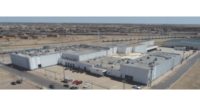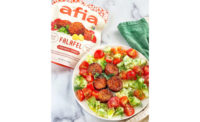How many falafel are in a truckload?
“Almost half a million. Half a million falafel. Give or take, give or take,” said Afia Foods CEO Yassin Sibai. “Roughly speaking, it wouldn’t take more than five, six people to run (our) whole line, to make a truckload of falafel.”
With a few workers in ingredient prep, quality control and packaging, it doesn’t take more than a handful of people and several pieces of specialized equipment to produce up to a half-million of the frozen chickpea patties each day.
The company has scaled twice: starting in a commercial kitchen and selling at an Austin-area Farmer’s Market in 2017 and, along the way, operating out of a retrofitted 5,000-square-foot former steakhouse with no office space. But, after a year of COVID-related delays that included the unfortunate death of their general contractor, the first falafel rolled off the fully-automated production line at the company’s new, 21,000-square-foot facility in August.
The entire building is a cold environment, “purpose built” in Taylor, Texas, for highly automated frozen food production.
“If you don't have the right plumbing, it's a disaster and that ripples into the product quality and safety and so on. There's so many things to it, so the plumbing was the very No. 1 item,” Yassin Sibai said. “All the inside of the building itself is like you're in a freezer room. The whole building is IMP panels, basically. It also helps with the production line and product flow. Because we designed the whole thing from the ground up, we understand our processes, like our processing, our assembly line kind of steps and our workflow. All of the moving parts, the product almost kind of flows naturally in one direction, and then one direction out. Our storage freezer space holds about 300 pallets, but we operate literally right next door to a 3PL that has over 3,000 pallet spots. So we knew we could scale, exponentially, just by relying on our next door neighbor.”
The space provides two manufacturing capabilities: Fry, Freeze & Pack pouch bags and also a Meals line production and packaging. Afia’s encrusting machines can produce croquettes, dumplings or other filled doughs, with possibilities ranging from current kibbeh line to mini desserts. The extruders can produce multiple shaped doughs or minces, ranging from the classic falafel pucks to tots, nuggets, burgers and beyond. The variable speed continuous filtration oil fryer and 35-foot nitrogen-powered IQF freezer tunnel cooks and seals in flavor, freshness and moisture.
The new facility allowed Afia to launch four new product SKUs via a line of frozen single serve entrees in paper bowls and expand its falafel production by 10 times.
“Food is very memorable, so when you're eating it, I want my consumers to be able to have an experience as well as just taste the food, I want them to experience, and they get that out of our bowls, they get that because it's not a black plastic tray, it's a beautiful patterned bowl, it's a Syrian heritage tile on the bowl, um, and it just elevates the whole experience,” said Afia Foods Co-Founder and President Farrah Moussallati Sibai.
The lines also produce a traditional staple, kibbeh, available regionally and in foodservice. The kibbeh uses custom extruding capabilities to enable a once painstakingly handmade product be available to more people.
“Every time we got invited to a party or a gathering and it was a potluck, my mother-in-law was always the one that was asked to make kibbeh and she would sit down and it would take her an hour to make 50 kibbehs. That's just making it and forming it without the prep work of doing the dough and the stuffing. And people, when they, when they try it, if they don't know it, they love it straight away. So I've got to find a way to automate this,” Farrah Sibai said. “So, our first machine wasn't made for kibbeh. We had to adapt it and we had to, you know, change certain parts and add different types of molds and cutters and hoppers and things for it to be able to make the kibbeh. At the time I, I think that was probably the happiest day of my mother-in-law's life. I mean, this machine … could do 6,000 an hour versus doing those like 50 a minute.”
This spring, the company will be in over 13,000 points of distribution.
For more, listen to the podcast in the player above, or wherever you get your podcasts.









